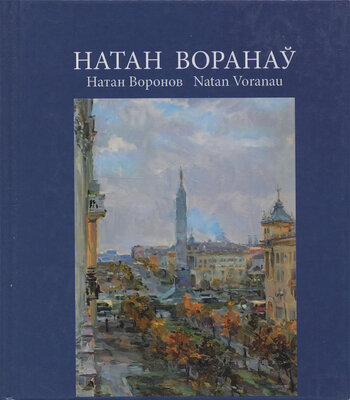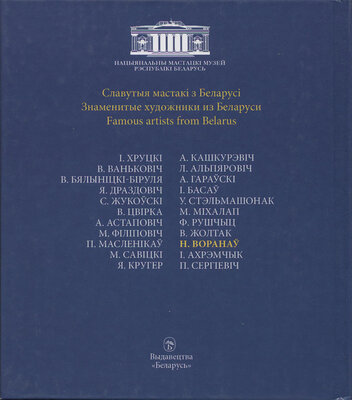Натан Воранаў
Выдавец: Беларусь
Памер: 99с.
Мінск 2016
N. Voranau’s landscapes as well as his other works are characteristic of the fine colour choice and harmonious colour combinations. The artist himself stressed: “The important thing is colour which reveals the essence of an event and does not serve for self-expression of an artist”12.
11 Печников, E. Творческие поиски IE. Печников II Литература и искусство. — 1966. — №2. — С. 6.
12 Бадин, Р. Г. Натан Моисеевич Воронов. — С. 8.
In the industrial landscapes and cityscapes, N. Voranau masterfully recreated kaleidoscope of contemporary life of Belarusian cities, captured the uniqueness of their image, characteristic features of everyday life, work and leisure of their citizens.
N. Voranau manifested his talent, perhaps, in all major genres. From time to time, the artist painted still-lives with pleasure. They are distinctive due to the simple laconic composition but they are always extremely complicated in colour (Roses, 1956; A Sunny Day, 1958; Window, 1964; An Open Window. The Spring Has Come, 1972; September. Sunflowers, At the Artist’s Studio, both — 1973). The master seemed with their help to perfect his skills in seeing the variety of colour combinations in the material world. Making the task more complicated, the artist often painted bouquets against the window. It is known that conveying the effect of counter light (when the source of light makes a silhouette out of an object) is very difficult in painting. There is a danger to “blacken” the painting. However, the master seemed to have no such a problem. He skillfully distributes the tone gradation throughout the canvas, while maintaining the right balance of colour and form.
As a rule, N. Voranau put a still-life into the interior complementing the main composition. There is a unique mood and the breath of time in each of the abovementioned paintings. The artists still-lives with tender, smoky and as if melting colours and shimmering, elusive forms are in many ways consonant with interior compositions of outstanding Belarusian artist Stanislau Zhukousky and with the traditions of the short-lived in the early twentieth century association “Blue Rose”.
In the painting An Open Window. The Spring Has Come the breath of the fresh, still frosty air that burst into the room is felt almost on the physical level. An uncomplicated composition is built on contrasts of colour and light. In the room immersed in the twilight, all items are painted in the finest tonal nuances. A view of awakening nature looks like a bright accent in the wide-open window. Life is going on there manifesting itself in the already high azure sky, bright sun flecks laying down on the roofs of houses in intricate patterns, branches of still leafless trees, and the dazzling snow beginning to melt. Depicting this view, Voranau put in it all his temperament of the artist, all the rave of colours, of which only he was capable. It seems that even the street noises are heard in the quiet room, where everything is silent... It is in the stilllives by the master that an internal, symbolic and poetic content of art hidden behind unpretentious external forms remains the fundamental part.
In his last year Natan Voranau was very ill. He passed away being 61 at the peak of his creative powers. Until the end of his life the artist never ceased to
create. Painting for him was akin to a natural human need to breathe. How much more Natan Maiseevich Voranau conceived, how many plans he bore in his heart — it will always be a mystery for us. However, the paintings that the artist left behind are the greatest treasure of Belarusian art. The artist was buried in the Paunochnaye cemetery near Minsk.
Works by Natan Voranau are kept in the National Art Museum of the Republic of Belarus, the Museum of Contemporary Art in Minsk (now, the National Centre for Contemporary Arts), in the funds of the Belarusian Union of Artists, in the Museum of the History of the Belarusian State University of Physical Training, in the private collections in Belarus and foreign countries.
Natallia Syalitskaya
Салігорскі калійны камбінат. 1960
Солигорский калийный комбинат. 1960
Saligorsk Potash Plant. 1960
Партрэт М. В. Трубкіна. 1949
Портрет М. В. Трубкина. 1949
Portrait of M. V. Trubkin. 1949
Асушэнне балот на Палессі. 1960
Осушение болот на Полесье. 1960
Draining Wetlands in Palesse. 1960
Беларусь.
За ўладу Саветаў. 1966—1967 Белоруссия.
За власть Советов. 1966—1967 Belorussia.
For Soviet Power. 1966—1967
Раніца ў Кастрычніку. Мінск, 1917 год. 1955—1957
Утро в Октябре. Минск, 1917 год. 1955—1957
Morning in October. Minsk, 1917. 1955—1957
Мора. Лодкі. 1956
Море. Лодки. 1956
Sea. Boats. 1956
ОН
Капітан флагманскага парахода «Руслан» маёр П. С. Букаеў. 1949
Капитан флагманского парохода «Руслан» майор П. С. Букаев. 1949
Captain of the Flagship Steamer “Ruslan” Major P. S. Bukaev. 1949
Памяці аднапалчан сорак першага. 1973
Памяти однополчан сорок первого. 1973
То the Memory of Fellow Soldiers of Nineteen Forty One. 1973
Мінск. Плошча Перамогі. 1964
Минск. Площадь Победы. 1964
Minsk. Peramogi Square. 1964
Шахтабудаўнікі Салігорска. 1961
Шахтостроители Солигорска. 1961
Mine Builders of Saligorsk. 1961
Партрэт брыгадзіра I. П. Чабатара. 1960
Портрет бригадира И. П. Чеботаря. 1960
Portrait of Foreman I. P. Chebatar. 1960
Завод жалезабетонных вырабаў. 1960
Завод железобетонных изделий. 1960
Concrete Product Plant. 1960
Партрэт В. А. Зяцевай. 1963
Портрет В. А. Зятевой. 1963
Portrait of V. A. Zyatseva. 1963
Алея ў парку. 1958
Аллея в парке. 1958 An Alley in the Park. 1958
Нацюрморт. Кветкі. 1956
Натюрморт. Цветы. 1956
Still-Life. Howers. 1956
мквк
Партрэт дзяўчыны. 1954
Портрет девушки. 1954
Portrait of a Girl. 1954
Партрэт драматурга Я. С. Рамановіча. 1967 Портрет драматурга Е. С. Романовича. 1967 Portrait of Playwright Ya. S. Ramanovich. 1967
Партрэт артысткі Т. М. Пастунінай у ролі Марфы з оперы «Царская инвеста». 1956 Портрет артистки Т. М. Постуниной в роли Марфы из оперы «Царская невеста». 1956 Portrait of Performing Artist T. M. Pastunina as Marpha in the opera “The Tsar’s Bride”. 1956
Акно. 1964
Окно. 1964
Window. 1964
Акцябронак. 1961
Октябренок. 1961
A Little Octobrist. 1961
Аўтапартрэт з дачкой.1956
Автопортрет с дочерью. 1956
Self-Portrait with the Daughter. 1956
У майстэрні мастака. 1973
В мастерской художника. 1973
At the Artist’s Studio. 1973
У чаканні зімы. 1973
В ожидании зимы. 1973
Waiting for Winter. 1973
Адчыненае акно. Вясна прыйшла. 1972
Открытое окно. Весна пришла. 1972 An Open Window. The Spring Has Come. 1972.
Мінск. Інтэрнацыянальная вуліца. 1949
Минск. Интернациональная улица. 1949
Minsk. Internatsiyanalnaya Street. 1949
Марыначка. 1956
Мариночка. 1956
Marynachka. 1956
У цені. 1939
В тени. 1939
In the Shadow. 1939
Перад дажджом. 1973—1976
Перед дождем. 1973—1976
Before the Rain. 1973—1976
Вясна прыйшла. 1963
Весна пришла. 1963
The Spring Has Come. 1963
Партрэт мастака А. С. Бархаткова. 1955
Портрет художника А. С. Бархаткова. 1955
Portrait of Artist A. S. Barkhatkou. 1955
Поўдзень. 1959
Полдень. 1959
Noon. 1959
Поўдзень. Партрэт даяркі В. А. Міхайлоўскай, ветэрана працы. 1975 Полдень. Портрет доярки В. А. Михайловской, ветерана труда. 1975 Noon. Portrait of Labour Veteran Milkmaid V. A. Mikhailouskaya. 1975
Лён.1956
Лен. 1956
Flax. 1956
Поўдзень. 1958
Полдень. 1958
Noon. 1958
На лініі. 1972
На линии. 1972
On the Line. 1972
Цікавая кніга. 1954
Интересная книга. 1954 An Interesting Book. 1954
Беларусь — мая песня. Партрэт 1.1. Жыновіча і В. А. Бурковіча. 1970—1971
Беларусь — моя песня. Портрет И. И. Жиновича и В. А. Бурковича. 1970—1971 Belarus Is Му Song. Portrait of 1.1. Zhynovich and V. A. Burkovich. 1970—1971
Партрэт Янкі Купалы. 1972
Портрет Янки Купалы. 1972
Portrait of Yanka Kupala. 1972
«Сонейкам цёпленькім, зеленню вабнаю абдаравала зямельку вясна». 1972
“The Warm Sun, the Inviting Green Has Presented to the Land Spring”. 1972
Спіс ілюстрацый
Старонка СПИСОК ИЛЛЮСТраЦИЙ Страница *
Page List of illustrations
43 Салігорскі калійны камбінат. 1960. Палатно, алей.
Солигорский калийный комбинат. 1960. Холст, масло.
Saligorsk Potash Plant. 1960. Oil on canvas.
44 Партрэт M. B. Трубкіна. 1949. Палатно, алей.
Портрет М. В. Трубкина. 1949. Холст, масло.
Portrait of М. V. Trubkin. 1949. Oil on canvas.
45 Асушэнне балот на Палессі. 1960. Палатно, алей.
Осушение болот на Полесье. 1960. Холст, масло.
Draining Wetlands in Palesse. 1960. Oil on canvas.
46-47 Беларусь. Заўладу Саветаў. 1966—1967. Палатно, алей.
Белоруссия. За власть Советов. 1966—1967. Холст, масло.
Belorussia. For Soviet Power. 1966—1967. Oil on canvas.
48-49 Раніца ў Кастрычніку. Мінск, 1917 год. 1955—1957. Палатно, алей.
Утро в Октябре. Минск, 1917 год. 1955—1957. Холст, масло.
Morning in October. Minsk, 1917. 1955—1957. Oil on canvas.
50 Mopa. Лодкі. 1956. Палатно, алей.
Море. Лодки. 1956. Холст, масло.
Sea. Boats. 1956. Oil on canvas.
51 Капітан флагманскага парахода «Руслан» маёр П. С. Букаеў. 1949. Палатно, алей.
Капитан флагманского парохода «Руслан» майор П. С. Букаев. 1949. Холст, масло.
Captain of the Flagship Steamer “Ruslan” Major P. S.Bukaev. 1949. Oil on canvas.
52-53 Памяці аднапалчан сорак першага. 1973. Палатно, алей.
Памяти однополчан сорок первого. 1973. Холст, масло.
То the Memory of Fellow Soldiers of Nineteen Forty One. 1973. Oil on canvas.
54 Мінск. Плошча Перамогі. 1964. Палатно, алей.
Минск. Площадь Победы. 1964. Холст, масло.
Minsk. Peramogi Square. 1964. Oil on canvas.
55 Шахтабудаўнікі Салігорска. 1961. Палатно, алей.
Шахтостроители Солигорска. 1961. Холст, масло.
Mine Builders of Saligorsk. 1961. Oil on canvas.
56 Партрэт брыгадзіра I. П. Чабатара. 1960. Палатно, алей.
Портрет бригадира И. П. Чеботаря. 1960. Холст, масло.
Portrait of Foreman I. P. Chebatar. 1960. Oil on canvas.
57 Завод жалезабетонных вырабаў. 1960. Палатно, алей.
Завод железобетонных изделий. 1960. Холст, масло.
 КНІГІ ОНЛАЙН
КНІГІ ОНЛАЙН


